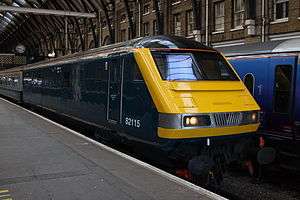British Rail Class 19
| British Rail Class 19 | |||||||||||||||||
|---|---|---|---|---|---|---|---|---|---|---|---|---|---|---|---|---|---|
 Mark 3 DVT similar to the donor vehicle used for the Class 19 conversion | |||||||||||||||||
| |||||||||||||||||
| |||||||||||||||||
| |||||||||||||||||
Class 19[1] is the name given to an experimental railway locomotive being constructed using a Mark 3 DVT. The locomotive is part of a project funded by the Rail Safety and Standards Board (RSSB) to test the viability of combining hydrostatic transmission with a form of regenerative braking that can reduce engine emissions.[2]
Hydrostatic transmissions have been used previously for rail vehicles, but only for slow-speed track maintenance vehicles and similar, not for mainline locomotives. Diesel-hydraulic locomotives instead use a hydrodynamic, i.e. torque converter, transmission.
History
In 2017, the RSSB announced that it planned to fund the development of an experimental rail vehicle in conjunction with Artemis Intelligent Power, a developmental company specialising in hydraulic machines.[3] The intention of the project was to develop a rail vehicle that could store braking energy, which could then be released during acceleration. It would be powered by diesel engines as the prime mover, driving hydraulic pumps and then hydraulic motors mounted on the axles. These motors could also act as pumps, storing braking energy in hydraulic accumulators.[1] This type of system is being offered as a potential solution for use in areas that are not economical to electrify.[4]
The RSSB and Artemis entered into a collaboration with Chiltern Railways to obtain a suitable vehicle, with one of Chiltern's DVTs chosen as the donor vehicle.[5] The vehicle, 82113, was moved for conversion to the Bo'ness and Kinneil Railway in July 2017, where work began. This involved the installation of the JCB diesel engines, the Artemis E-dyn 96 Digital Displacement Hydraulic Pump and the axle mounted motors. The vehicle was also fitted with a second cab by the removal of the guard's compartment, allowing it to be driven from either end.[1] The vehicle was started for the first time on 20 July 2018.[6] Commissioning trials began on 1 August 2018 jointly between Artemis and the SRPS Diesel Group.[7]
References
- 1 2 3 4 ""Class 19" takes shape". Today's Railways. No. 201. September 2018. p. 62.
- ↑ "RSSB funds powertrain demonstrator". RSSB. 10 March 2017. Retrieved 21 August 2018.
- ↑ "History". Artemis Intelligent Power. Retrieved 21 August 2018.
- ↑ Roden, Andrew (11 September 2018). "Motorised former Mk3 Driving Van Trialer starts testing". Rail (860): 8.
- ↑ "New 'Loco' Takes Shape". Rail Express. 21 September 2017. Retrieved 21 August 2018.
- ↑ "DVT Loco start up". BONESS27001. Youtube. 20 July 2018. Retrieved 21 August 2018.
- ↑ "Ex DVT 82113 commissioning trials at Bo'ness". BONESS27001. Youtube. 9 August 2018. Retrieved 21 August 2018.